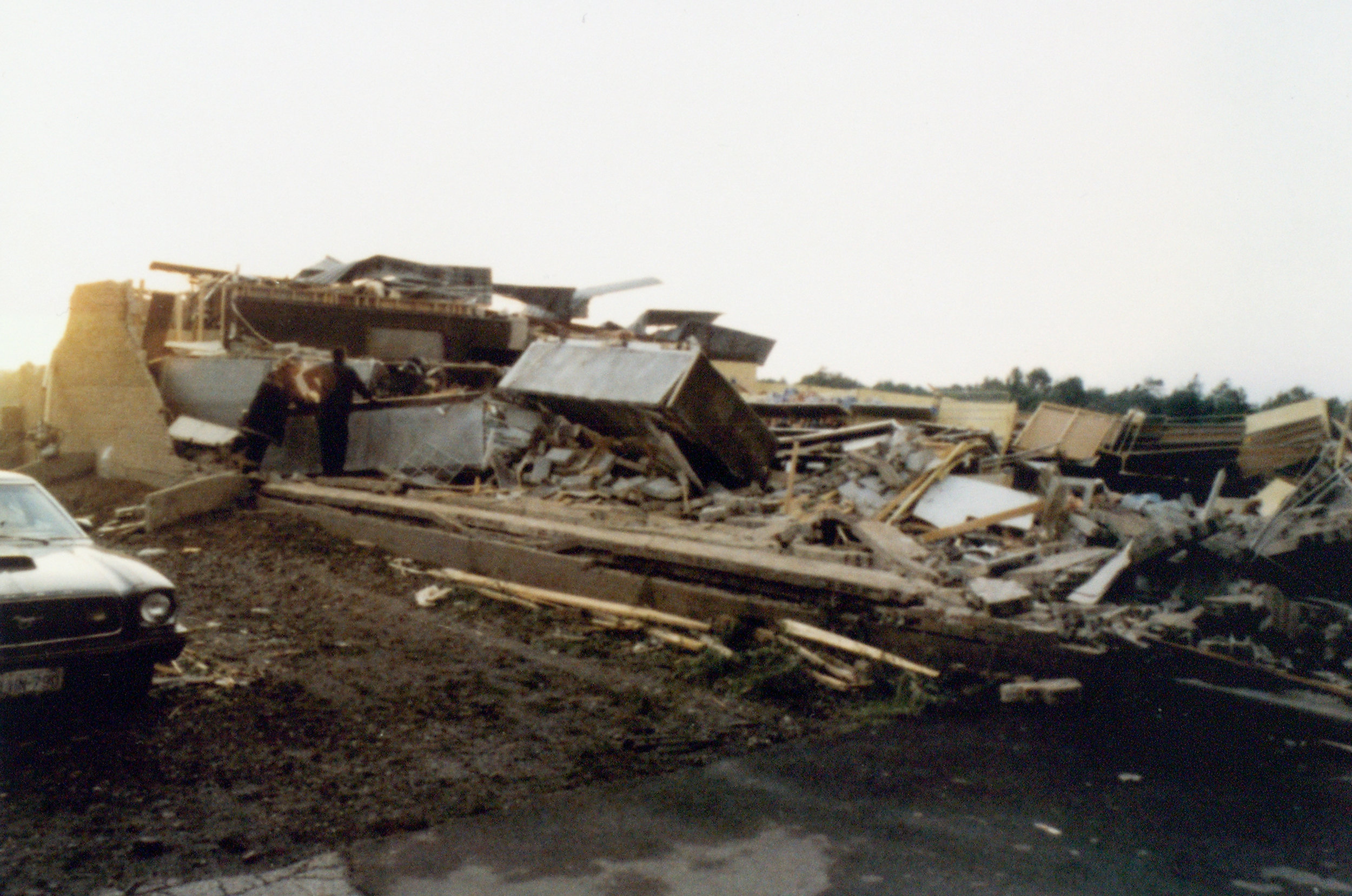A little over a year before I was born, a tremendously strong tornado barreled its way across my home county in Ohio. It did not touch my family, except that they, like so many others across the county, remembered heading down to the basement with a battery-powered radio and keeping their fingers crossed that nothing worse than rain would befall them. Nearly every summer as I was growing up, tornadoes would threaten northeast Ohio, and my parents would retell the story of that particular tornado. It stuck in their memories even though they had both been relatively safe and out of harm’s reach. That May 31, 1985 tornado was both something to fear and a source of wonder, of devastation and merciful coincidences.
Here is the story my parents told over and over again, about an event that happened seven miles from the house where I grew up. On the night the tornado hit, at a roller rink on a busy corner of Route 422 in Niles, Ohio, the local schools were scheduled to hold a skating party. When the tornado hit, just before 7pm, less than an hour remained before the party would start. The skating rink, along with the plaza nearby, suffered complete destruction--if the tornado had touched down even an hour later, that building could have been filled with children and teenagers skating the bunny hop and hokey pokey and oblivious to the winds brewing outside. That near-miss proved to be just one serendipitous story, but it loomed large for my parents and for me. The roller rink in my town, probably about 20 minutes from the one the tornado destroyed, would be a consistent point of reference for my entire youth from my school skating parties, to birthday parties for friends, to teenage years where they played edgier alt-rock on Friday nights and we debated whether or not to smoke in the bathrooms.
“Top O' the Strip and State Route 422, Niles, Ohio.,” Trumbull Memory Project, accessed June 2, 2019, http://trumbullmemory.org/items/show/87. This image of the destroyed skating rink is, specifically, part of the Tornado Memory Project undertaken by the Warren-Trumbull County Public Library.
It occurs to me now that I never bothered to look up any more about the tornado. I did not know, as I do now, that it was a rare F5 tornado with winds ranging above 300 miles per hour. It was supposedly the largest tornado in the world in 1985. I did not know, as I do from reading remembrances and looking at photos, that Niles was not the only community that was hit so hard. One news article told a similar story of luck in Newton Falls, a small city that the tornado hit first. A veteran storm-spotter and reserve police officer had been watching the skies from the roof of the City Hall and sounded the tornado sirens in time to give everyone full minutes to take cover. And no one died in Newton Falls, despite the fact that “seemingly half of Newton Falls was simply swept away by the storm.”
Perhaps because my parents had already seen the worst a tornado could bring, I never really grew up fearing tornadoes. When I was little and the weathermen issued a warning, my parents would help me gather my critical things--preferred stuffed animal, blankie, books--and we’d head for our cinderblock basement, where it seemed like nothing could touch us. I remember one time, after I could drive myself, when I went to the movies alone on a summer night. Suddenly, the movie stopped and the lights came up; a member of the theater staff explained that a tornado warning had been issued and that it was our choice to shelter in place at the theater or to drive home. I remember two things: 1) they did give us each a free pass to return, and 2) I chose to calmly get in my car and head home to my parents and the cinderblock basement as fast as possible. Nothing else happened that night. The movie theater is only two miles from where that skating rink had stood.
I lived in New Jersey when Hurricane Sandy hit. It was not my first hurricane, and I was not close enough to the shore to really be in danger. But that night, I stayed in my bed watching the weather on TV until the power went out, and then listened to audiobooks until I fell asleep finally, too exhausted to continue being upset by the wind and rain whipping at my poorly insulated windows. My friends and I went out the next morning and walked around our broken town to survey the damage. Trees barred sidewalks and roads, and no one had electricity so we kept our eyes open for downed lines. We noted that we’d be able to walk to school still because the bridge hadn’t flooded the way it did during Hurricane Irene. As we stumbled over piles of branches, I confessed that I had been terrified all night, and they said, “But you grew up in Ohio! Aren’t tornadoes a lot scarier?” I’m still not sure what the answer to that is. I do know that, the next day, I got into my car, thankful that I had enough gas in what became a serious shortage to make it to the Pennsylvania border, and drove home to my parents for a week. When I returned to New Jersey, my power still wasn’t back on.
As tornadoes moved across the Dayton area about a week ago, I was thinking about these storm experiences and checking radar maps to see whether my friends near there would be safe. I’m acutely aware of how tornadoes, like Trumbull County in 1985 or the storm that struck Lorain and Sandusky in 1924, live long after they end, as communities try to heal and rebuild. The likelihood for an Ohioan to experience a tornado that strong again in the same way is so small that the stories become tall tales, stretching up to point where they can hold the horror of their teller in their events. In the course of a research project in Lorain, I read story after story of that 1924 tornado, trying to fact-check a claim about a historic house. One story in particular kept haunting me weeks later; the tornado had swooped in from Lake Erie and hit a bathhouse on the beach, sucking off the roof and subsuming the people inside into the storm.
When we tell stories about past tornadoes, we know that our ancestors lacked our modern weather warnings and simply had no idea the storm was coming. Yet even with our sirens and sophisticated radar, the days after Dayton have revealed those same stories of how, if one easy thing had been a little later or if a wife hadn’t talked a husband into heading to the basement, already terrible things could have been made so much worse. And when we tell stories like this that are steeped in tragedy, we can easily lose sight of the facts, even as we endeavor to preserve this history for future generations. The 1985 tornado in Trumbull County colored my life in so many ways, even though I hadn’t yet been born, but I never bothered to look and see if the stories my parents had told me were really true.
It is, however, true that the most famous tornado in American history did not occur in real life. When a tornado picks up Dorothy Gale’s small farmhouse and spins her into a new world, she learns that her fantasy isn’t what she needs after all. In our real life, we must be careful to keep pointing toward “home” in telling our storm stories.
For more pictures, oral histories, etc., see the Tornado Memory Project, part of the Trumbull Memory Project at the Warren-Trumbull County Public Library.





